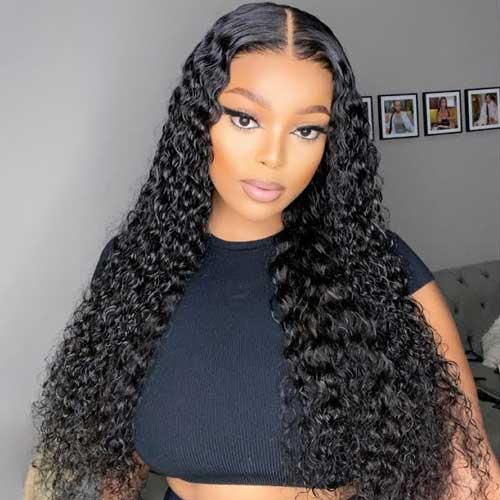How to Make a Wig Look Real

Wigs are a great way to change your look, experiment with different styles, or cover up hair loss. However, not all wigs are created equal, and some may look more realistic than others. If you want to wear a wig and make it look as natural as possible, there are some tips and tricks you can follow to achieve a flawless result. Here are some of the best ways to make a wig look real.

Choose the right wig.
The first step to making a wig look real is choosing the right wig for you. There are many factors to consider when buying a wig, such as the type of hair, the cap construction, the color, and the style.
1. Type of hair.
Wigs can be made of synthetic or human hair, or a blend of both. Synthetic wigs are cheaper and easier to maintain than human hair wigs, but they may not look as natural or last as long. Human hair wigs are more expensive and require more care, but they offer more versatility and realism. A blend of synthetic and human hair can give you the best of both worlds, but it may also have some drawbacks.
Synthetic wigs.
Synthetic wigs are often made of plastic fibers that can have an unnatural shine or texture. To make them look more matte and realistic, you can spray some dry shampoo or talcum powder on them. You can also use a mixture of fabric softener and water to condition them and make them more bouncy. However, you should avoid using hot tools or volumizing products on synthetic wigs, as they can damage them or make them lose their shape.
Human hair wigs.
Human hair wigs are made of real hair that can be styled and colored as you wish. You can use hot tools and products on them, but you should also protect them from heat damage and moisture loss. You should wash and condition them regularly with gentle products designed for wigs, and store them on a wig stand or a mannequin head when not in use.
A blend of synthetic and human hair can give you the benefits of both types of hair, such as lower cost, longer lifespan, and more styling options. However, you should also be careful about how you treat them, as they can have different reactions to heat and products. You should follow the manufacturer’s instructions on how to care for your blended wig.

2. Cap construction.
The cap construction refers to how the hair is attached to the base of the wig. There are different types of cap constructions, such as lace front, monofilament, hand-tied, wefted, and open cap. Each type has its own advantages and disadvantages in terms of realism, comfort, durability, and price.
Lace front wigs.
Lace front wigs have a thin strip of lace along the front edge of the wig that creates a natural-looking hairline. The lace is trimmed to match your forehead shape and glued or taped to your skin. Lace front wigs are very realistic and versatile, as they allow you to style your hair away from your face or create different partings. However, they can also be more expensive and delicate than other types of caps.
Monofilament wigs.
Monofilament wigs have a thin mesh material at the top or crown of the wig that allows each hair to move freely and create a natural-looking parting. Monofilament wigs are also very realistic and comfortable, as they mimic the appearance of your scalp and allow your skin to breathe. However, they can also be more costly and less durable than other types of caps.
Hand-tied wigs.
Hand-tied wigs have each hair individually knotted to the cap by hand, creating a very natural movement and density. Hand-tied wigs are also very comfortable and lightweight, as they do not have any seams or wefts that can irritate your scalp. However, they can also be very expensive and time-consuming to make.
Wefted wigs.
Wefted wigs have rows of hair sewn onto strips of fabric that form the cap. Wefted wigs are cheaper and easier to make than other types of caps, but they may not look as natural or comfortable. They can have visible seams or gaps between the wefts that can show through your hair or cause itching.
Open cap wigs.
Open cap wigs have spaces between the wefts that allow air circulation and reduce weight. Open cap wigs are more comfortable and breathable than wefted wigs, but they may also look less realistic or secure. They can expose your scalp or wig cap underneath if your hair is parted or styled in certain ways.
3. Color.
Choosing the right wig color can make a big difference in how you look and feel. Whether you want to match your natural hair color, try a new shade, or experiment with a bold hue, there are some factors to consider before buying a wig. Here are some tips to help you find the best wig color for you.
– Consider your skin tone and eye color.
Some wig colors may complement your complexion better than others. For example, if you have warm undertones, you may look good in warm colors like reds, browns, and golds. If you have cool undertones, you may prefer cool colors like blues, purples, and silvers. Similarly, your eye color can also influence your wig color choice. For example, if you have blue eyes, you may want to avoid blue wigs that can make your eyes look dull. Instead, you may opt for a contrasting color like brown or blonde that can make your eyes pop.
– Think about your personality and style.
Your wig color should reflect your personal taste and mood. If you want to look professional and sophisticated, you may choose a natural or neutral color that matches your own hair color or is slightly darker or lighter. If you want to look fun and adventurous, you may choose a bright or unusual color that stands out and expresses your creativity. You can also mix and match different colors to create highlights, lowlights, or ombre effects.
– Try on different wig colors before buying.
The best way to find out if a wig color suits you is to see it on yourself. You can visit a wig store and try on different styles and colors, or order online and use a virtual try-on tool. You can also ask for opinions from your friends or family members, or take photos and compare them. Remember to check the wig color in different lighting conditions, such as natural light, artificial light, and flash.

How to wear a wig while achieve a natural look?
Wearing a wig can be a great way to change your hairstyle, cover hair loss, or experiment with different looks. However, you may also want to achieve a natural look that blends well with your own hair and scalp. Here are some tips on how to wear a wig while achieving a natural look.
1. – Choose a wig that matches your natural hair color and texture.
If you have dark brown curly hair, for example, you may want to avoid a blonde straight wig. You can also look for wigs that have highlights or lowlights to add some dimension and depth to your hair.
2. – Trim the wig to fit your face shape and style.
You can take your wig to a professional stylist or do it yourself at home. You may want to cut some bangs, layers, or fringe to frame your face and hide the hairline. You can also use scissors or thinning shears to trim the ends and reduce the bulkiness of the wig.
3. – Secure the wig with clips, combs, or glue.
You can use wig clips or combs to attach the wig to your natural hair or a wig cap. You can also use wig glue or tape to adhere the wig to your scalp. Make sure the wig is snug but not too tight, and that it covers your hairline and ears.
4. – Style the wig with heat tools or products.
You can use a curling iron, flat iron, or blow dryer to style your wig as you would your natural hair. However, make sure the wig is heat-resistant and use a low heat setting to avoid damaging the fibers. You can also use products such as mousse, gel, or hairspray to add some volume, texture, or hold to your wig.
5. – Accessorize the wig with hats, scarves, or headbands.
You can use accessories to add some flair and personality to your wig. You can also use them to cover any visible seams or edges of the wig. For example, you can wear a hat or scarf over the top of the wig, or a headband around the front of the wig.
The ways to styling a human hair wig to make it look real.
Human hair wigs offer a versatile and realistic option for those seeking to enhance their appearance or deal with hair loss. To ensure that your wig looks and feels natural, styling plays a crucial role. With a few simple techniques and tricks, you can achieve a seamless and authentic look that mimics real hair.
Customization and professional assistance.
Before diving into styling, it’s essential to customize your wig for a perfect fit. Visit a professional stylist experienced in working with wigs to have it properly sized and shaped to your head. They can also trim the wig to suit your face shape, making it appear more natural.
Styling techniques.
Parting: Experiment with different parting styles to create a natural look. Use a rattail comb to create a middle or side part, matching your natural hairline.
Styling products:
Use lightweight styling products like hairspray, mousse, or serums to control flyaways and add texture to the wig. Avoid products with heavy or sticky formulas that may weigh down the hair.
Wig accessories.
Add accessories like headbands, scarves, or hats to enhance the natural appearance of your wig and personalize your style.
Remember this.
Styling a human hair wig to achieve a natural and realistic look requires attention to detail and the use of appropriate techniques. Remember to customize the wig for a perfect fit, prepare it with specialized care products, and employ styling techniques that mimic natural hair. Don’t forget the finishing touches, such as blending your natural hair, using lightweight styling products, enhancing the hairline, and adding accessories. By following these tips, you can confidently wear your human hair wig and enjoy a striking, authentic look that enhances your natural beauty.
